Drug antagonism
- Affinity: The tendency of a drug to bind to the receptors.
- Efficacy: Once bound, tendency to activate the receptor.
- Agonists:
Drugs that bind to physiological receptors and mimic the regulatory effects of the endogenous signalling compounds
- Partial Agonists:
Agents that are only partly as effective as agonists regardless of the concentration employed
- Inverse Agonists:
An agent that binds to the same receptor as an agonist but induces pharmacological response opposite to that of agonist.
Threshold: Dose that produces a just-noticeable effect.
ED50: Dose that produces a 50% of maximum response.
Ceiling: Lowest dose that produces a maximal effect.
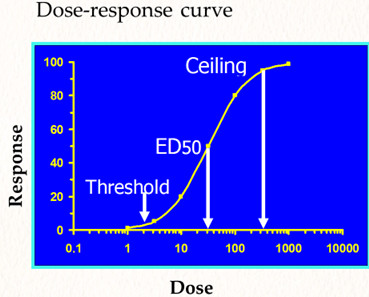
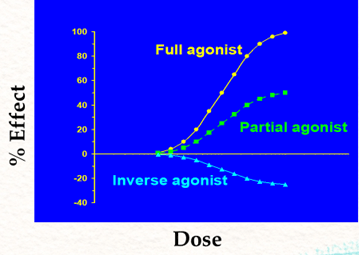
- Antagonists:
Drug that binds to receptors but cannot initiate a cellular response, but prevent agonists from producing a response;
Has affinity, but no efficacy.
- Drug Antagonism
The process of inhibition of an agonist-driven cellular response by another molecule.
effect of drugs A + B < effect of drug A + effect of drug B
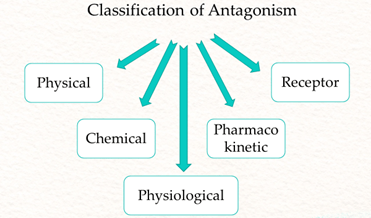
- Physical Antagonism
Charcoal adsorbs alkaloids and can prevent their absorption
Therapeutic management of alkaloidal poisonings
- Chemical Antagonism
Chemical antagonism refers to the uncommon situation where the two substances combine in solution; as a result, the effect of the active drug is lost
The two drugs react chemically and form an inactive product, e.g.
• KMnO4 oxidizes alkaloids—used for gastric lavage in poisoning.
• Chelating agents (BAL, Cal. disod. edetate) complex toxic metals (As, Pb).
• Nitrites form methaemoglobin which reacts with cyanide radical.
- Positively charged protamine counteracting negatively charged heparin
- Drugs may react when mixed in the same syringe or infusion bottle:
- • Thiopentone sod. + succinylcholine chloride (T+S former will get hydrolyzed bcoz of strong alkalinity of the latter)
- Phenytoin +glucose solution (Glucose has low pH so phenytoin anion is partly ppt as less soluble acid)
- Physiological/functional antagonism
The two drugs act on different receptors or by different mechanisms, but have opposite overt effects on the same physiological function, i.e. have pharmacological effects in opposite direction,
e.g.• Histamine and adrenaline on bronchial muscles and BP.
• Glucagon and insulin on blood sugar level.
- Pharmacokinetic Antagonism
Pharmacokinetic antagonism describes the situation in which the ‘antagonist’ effectively reduces the concentration of the active drug at its site of action.
Absorption
Drugs which slows the gastric emptying such as opioids or antimuscarinic agents reduce absorption in general.
Calcium forming an insoluble complex with tetracycline.
Cholestyramine decreases absorption of digoxin, warfarin.
- Metabolism
- e.g. the reduction of the anticoagulant effect of warfarin when an agent that accelerates its hepatic metabolism, such as phenytoin, is given.
- Drugs like rifampicin, phenytoin, or carbamazepine are potential enzyme inducers which can lead to OCP failure
- Phenobarbitone is used in treatment of kernicterus where it enhances the conjugation of bilirubin.
- Elimination
sodium bicarbonate used for forced alkaline diuresis for barbiturate poisoning.
Receptor antagonism
- Competitive antagonism/Surmountable antagonism.
- Non-surmountable /noncompetitive antagonism
- Allosteric
- Irreversible
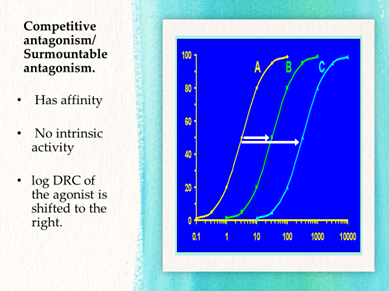
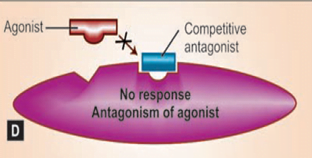

- USES- to prevent the activity of drugs
-to reverse the effects of drugs that have already been consumed.
- Naloxone reverse opioid overdose caused by drugs such as heroin or morphine.
Flumazenil is an antidote to benzodiazepines.

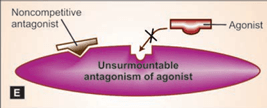
Allosteric Antagonism
Binds to a site other than the agonist binding site called as allosteric site.
- Maraviroc is a negative allosteric modulator of the CCR5 receptor
The drug binds to CCR5, thereby blocking the HIV protein gp120 from associating with the receptor. HIV is then unable to enter human macrophages and T cells.
Cinacalcet allosteric activation
Cinacalcet increases the sensitivity of calcium receptors on parathyroid cells to reduce parathyroid hormone (PTH) level
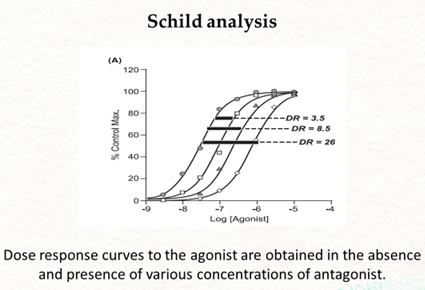
The resulting shifts to the right of the agonist dose response curves are converted to dose ratios (DR) and utilized in the Schild equation to construct a Schild regression
Clinical Significance of drug antagonism
• Correcting adverse effects of drug;
e.g., chlorpromazine induced extrapyramidal reactions which are due to cholinergic activation can be countered by benzhexol
• Treating drug poisoning;
e.g., morphine with naloxone, organophosphorus compounds with atropine
• Predicting drug combinations which would reduce drug efficacy,
e.g., the penicillin and tetracycline combination is inferior to penicillin alone in pneumococcal meningitis.
Detecting Antagonism during Drug Development Process
- Preclinical studies- Bioassay
- ADR Reporting
- Phase IV- Pharmacovigilance
- Case Reports and Publishing research
- Drug interactions between herbal drugs and allopathic drugs
